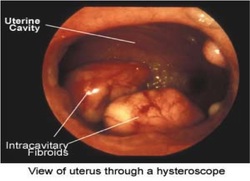
The female uterus is made up of numerous muscle fibres, which are collectively lined internally by fleshy cells (endometrium).
Fibroids are benign growths that originate from the muscle of the womb. In fact each muscle fibre has the potential to grow into a fibroid.
Fibroids are the commonest growth affecting the female genital tract.
They are hormone dependent tumors and tend to grow because of oestrogen stimulation.
Who do they affect?
Depending on the age and race of the population studied they can be seen in up to 50% of the female population. In the majority of women with fibroids there are no symptoms.
They are more common in Afro-Caribbean than in Caucasian women. They tend to present earlier in Afro-Caribbean women and tend to present more commonly as problems with fertility in this group. Caucasian women with fibroids are more likely to have children and complain of heavy menstrual bleeding.
Fibroids tend to run in families
They are commoner in heavier women
They are less common in women who smoke
Why they may be important
The majority of women with fibroids have no symptoms, but when symptoms occur they can be responsible for
1. Heavy menstrual periods
a. Leading to anaemia
2. Infertility
3. Pressure symptoms
a. Pressure on bladder causing urinary symptoms
b. Pressure on bowel causing obstruction and constipation
The symptoms they cause depend on the location of the fibroids
Those within the cavity of the uterus or distorting the cavity are more likely to be responsible for symptoms of heavy bleeding and infertility.
Considerations for treatment
The approach to treating fibroids in women who have symptoms depends on
1. The size of the fibroid
2. The location of the fibroid
3. The number of fibroids
4. The symptoms that the fibroids are causing
5. Fertility issues
For women with small fibroids and only heavy periods they may be advised to use medication to ease their symptoms.
For women with significant fibroids, or problems with fertility are usually advised to have surgery.
Hysterectomy is NOT the treatment of choice. It should only be considered in women who have completed their families. Some women who have completed their families may not be comfortable with a hysterectomy. In these women alternative treatments should be considered.








 RSS Feed
RSS Feed